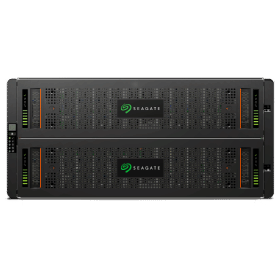
Denned - Fotolia
StorOne builds hybrid flash arrays based on Seagate hardware
StorOne S1 flash management stack is tuned for optimal run on Seagate Exos Application Platform 5U servers. Four configurations are available that mix Seagate disk and SSDs.
StorOne teamed with Intel last year to launch an all-flash array designed for extreme performance. On Tuesday, the startup unveiled storage "for the rest of us," with hybrid arrays based on dense Seagate hardware.
The new series packages StorOne S1 storage management software on Seagate Exos Application Platform 5U servers. Four configurations are available that mix Seagate disk and SSDs. A single StorOne hybrid node is rated to deliver 200,000 IOPS from flash and more than 1 petabyte (PB) of disk storage. StorOne claims its vRAID technology can complete drive rebuilds in less than two hours.
"Our partnership with Intel targets use cases that need extreme performance, but not everyone needs 1 million IOPS. I call this new array a storage solution for the rest of us," StorOne executive George Crump said.
 George Crump
George Crump
Pricing for the new StorOne block arrays starts at $112,881 for a base model with 250 TB. Two midrange arrays are available: One version scales to 642 TB and is priced at $135,599, while a larger model provides 887 TB for $199,965. The highest-capacity StorOne-Seagate array is priced at $249,564 and scales to 1.3 PB, which includes up to 215 TB of flash. Customers can price the varying configurations with StorOne's TruPrice portal and purchase the arrays via Seagate's channel.
Tangling with competitors
StorOne wants to go toe-to-toe with midrange storage by Dell EMC, Hitachi Vantara, HPE Nimble Storage, NetApp and Pure Storage. Dave Raffo, a senior analyst at Evaluator Group, said StorOne took a different approach from software-defined storage software that runs on x86-based servers.

Raffo said StorOne tuned its S1 stack to specifically optimize Seagate's server technology. He added that the StorOne-branded Seagate arrays especially target HPE Nimble's Adaptive Flash hybrid arrays.
"They seem to be aiming this at Nimble the most," Raffo said about StorOne. "Their strategy is they can beat Nimble's performance, but at a substantially lower price. Nimble has InfoSight predictive analytics and better integration with VMware and the major backup vendors. If you're talking about just pure performance and price, StorOne thinks they can beat Nimble.
"This system is not for people who run high-transactional databases or need all-flash storage," Raffo added. "A lot of people just want a good storage system that works" and doesn't break the budget.
StorOne: Hybrid arrays still in demand
New flash technologies like NVMe and storage class memory have overshadowed hybrid arrays in recent years, with vendors steering customers to buy all-flash systems during the refresh cycle. Crump pointed to fluctuating prices for NAND flash as proof that hybrid arrays remain a viable option for certain users.
StorOne's All-Flash Array.next (AFAn) debuted last year. The two-tiered AFAn uses Intel Optane drives for performance and quad-level cell NAND SSDs for bulk storage. The Seagate-based StorOne hybrid platform is multiprotocol storage that covers a range of production and backup use cases, Crump said.
StorOne uses a Linux architecture, although Linux is used only as an interface to the physical drives. S1 is a thin management stack that includes proprietary data services. The algorithm allows data services to interact in parallel with IO without degrading performance. StorOne erasure coding uses the parallel bandwidth of all drives to rebuild data. StorOne claims its vRAID technology can complete rebuilds in less than two hours on drives at 55% capacity.
Seagate Exos chassis have dual controllers for high availability and support self-encrypting drives. Capacity expands with the addition of two Seagate disk chassis. StorOne software approves new drives added to the storage pool.





